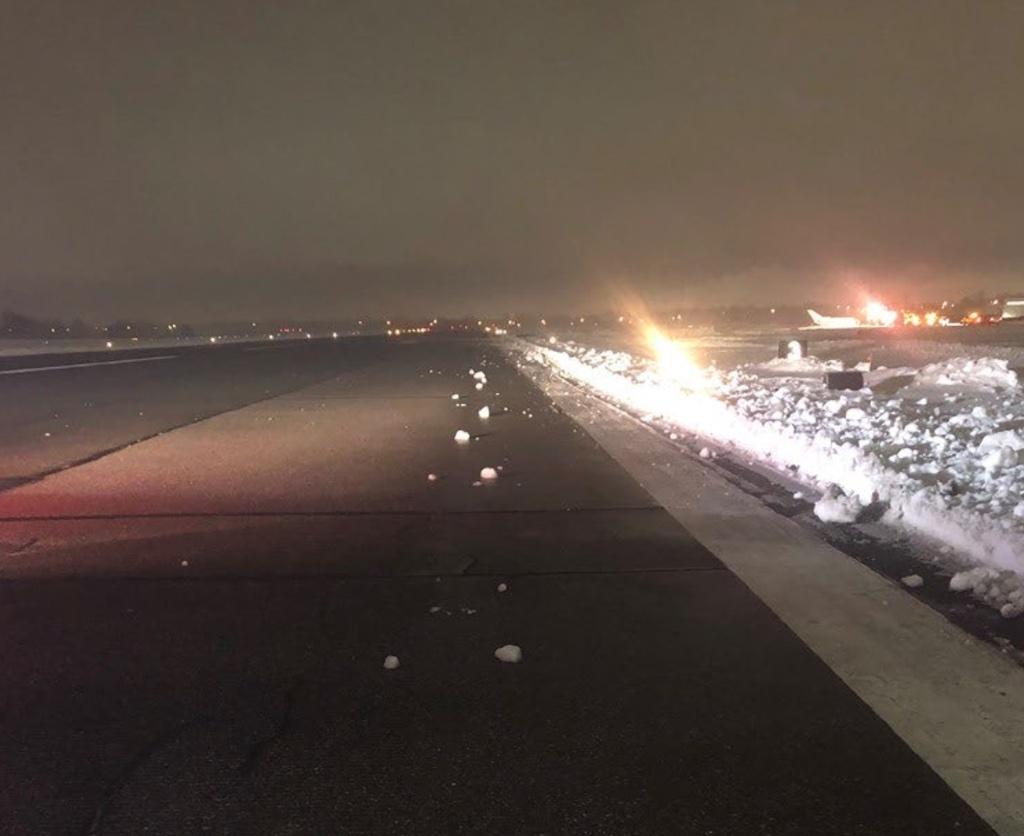
Snow disruption on right side of runway with accident aircraft in the background.
What is commonly taught to professional pilots in flight simulator training is that if you do see one of the 10 elements listed in 91.175 (c)(3) you may continue and land. The flight visibility requirement of subparagraph (c)(2) is forgotten, superseded by the pilot’s view of one of the elements of the runway environment.
I respectfully disagree. The regulation doesn’t become void the moment you see the threshold. The problem is figuring out how flight visibility translates to runway visibility. Flight visibility is what is seen from the cockpit in flight and is measured by what prominent objects can be seen.
A pilot may be tempted to say the flight visibility is 3/4 mile, for example, but if he can’t see about 4000 ft. ahead when at minimums, it’s doubtful he has adequate visibility for the approach. A MALSF light system, such as is installed at FRG, is 1400 ft. long. When the sequenced flashing lights are first visible, the pilot should probably be able to see up to 2600 ft. of the approach end of the runway.
The regulation is clear enough, but overly optimistic interpretation of the visibility by pilots in a fast moving aircraft can quickly increase the risk of an accident.
Conclusions And Comments
Whether you’re in a car, a truck or a plane, when you’re on that last mile after four days of being away, you’re looking forward to being done and going home. Our Hawker crew was homeward bound and had reason to think they would soon be done.
When they left OPA, they expected the ceiling and visibility to be 800 ft. and 6 m. at FRG, and the area forecast warning about patchy fog was not strong enough to alter their plan. However, the ceiling and visibility was gradually falling as the flight continued to its destination. The crew had a natural bias to continue. Plan continuation bias is the cognitive bias to continue with the original plan despite changing conditions and growing evidence that you should reconsider. It explains the crew’s mindset as they descended to Long Island.
Had the ceiling and visibility remained at or above the prescribed minimums, the crew likely would have landed successfully. When the pilots received the news that the ceiling was now indefinite at 200 ft. and the visibility was 1/4 mile, they took about 10 seconds to absorb the information and make the decision to continue. They were only about two minutes from touchdown.
Ten seconds was not enough time to consider how to fly what could be in effect a Cat II approach. They needed to verbalize when the autopilot would be disconnected, what the approach lights would need to look like, how much of the runway surface would need to be visible in order to land, and who would initiate and conduct a go-around.
When the captain called out the red terminating bar lights, he was saying what he expected to see, not what was there. Human performance experts say expectation bias is when we have a strong belief or mindset toward something we expect to see or hear, and act according to those beliefs.
When the FO said in a post-accident interview that he saw Runway End Identifier Lights (REIL), he still believed those lights were there, but they were not. On the CVR, he never called out seeing anything. Investigators know that people often remember things that didn’t actually happen.
When the FO suddenly and unexpectedly relinquished control of the aircraft below 20 ft., he caught the captain by surprise. The captain declined to take control of the aircraft; doing so would have been a violation of the company’s “positive transfer of controls” policy. As a result, it appears that neither pilot pitched the airplane up to a go-around attitude.
Given that the FO was new to the operation, it’s not surprising the crew coordination broke down at the last minute. The pilots’ crew resource management training was not sufficient to ensure they both had an accurate shared mental model of how to conduct the approach with such low visibility.
The NTSB’s probable cause was: “The flight crew’s delayed decision to initiate a go-around after the approach had become unstabilized, which resulted in a hard landing.”
I would add that the “look see” nature of 91.175 is an invitation to error. Weather conditions can change faster than your expectations. A safer policy would be to break off the approach and proceed to your alternate as soon as the visibility drops below minimums.
Cause & Circumstance:Below Minimums Hard Landing, Part 1: https://aviationweek.com/business-aviation/safety-ops-regulation/cause-…
Cause & Circumstance: Below Minimums Hard Landing, Part 2: https://aviationweek.com/business-aviation/safety-ops-regulation/cause-…





